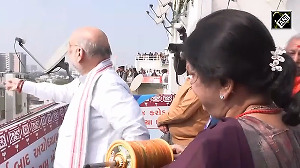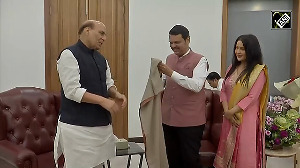'On hard cases like this one, the Supreme Court has only episodically stood against Parliament and the executive government.'
'I worry that this decision sets a precedent where President's rule is imposed in another state... and during the operation of President's rule, the state is fundamentally altered.'

A month ago, on December 11, 2023, the Supreme Court unanimously upheld the Centre's decision to abrogate Article 370 of the Constitution, that bestowed special status upon the erstwhile state of Jammu and Kashmir.
The apex court also upheld the validity of the Union government's decision to carve out the Union Territory of Ladakh from the erstwhile state of Jammu and Kashmir, although it did not adjudicate upon the validity of the reorganisation of J-K into UTs.
Holding that Article 370 was a temporary provision, the apex court ruled that J-K had no internal sovereignty and the concurrence of the state government was not required to apply the Indian Constitution to the state.
Although the court held as invalid (external link) the Constitutional Order 272, that changed the meaning of 'J-K Constituent Assembly' to 'J-K Legislative Assembly' and 'J-K Government' as 'Governor', this conclusion did not affect the outcome of the judgment since it held that the recommendation of J-K Constituent Assembly was not necessary for the President to declare Article 370 as inoperative.
Arghya Sengupta, founder and research director at the Vidhi Centre for Legal Policy, who also authored Hamīñ Ast: A Biography of Article 370 (external link), spoke to Rediff.com's Utkarsh Mishra about the Supreme Court verdict against which several review petitions were filed on January 10, 2024.
"The Supreme Court is a largely conservative institution, interpreting a largely conservative Constitution. It was thus no surprise that it found a baseline of enhanced integration and unity underlying Article 370 and the overall relationship between J-K and India," says Sengupta.
In your book Hamīñ Ast: A Biography of Article 370, you wrote, 'Any justification that seeks to legitimise the nullification of Article 370 overlooks both the historical context of Article 370 as well as the legal text.'
In this context, how do you see the Supreme Court's December 11, 2023 order in the case?
Politically, four-and-a-half years after the nullification of Article 370 on the 5th and 6th of August, 2019, there was resignation to the fact that it is time for everyone to move on and chart a new future for Jammu and Kashmir.
The judgment of the Supreme Court in the Article 370 matter appears to have done just that -- signalled to all parties that it is time to move on.
Central to this moving on is its finding in the Chief Justice's judgment that the purpose of Article 370 was always to 'enhance Constitutional integration between the Union and the State of Jammu and Kashmir'.
Once this was found to be the rationale for the provision, it is a logical inference that a move that ensures full and final integration of Jammu and Kashmir would be found wholly in line with that purpose.
Yet, this is where the court fundamentally erred.
The purpose of Article 370 was neither enhancing integration with India nor furthering autonomy of the state -- rather, if a single purpose is to be found (that itself is a questionable premise, whether a provision is incapable of having more than one purpose) it is that of collaboration -- that any decision on the future of the state of Jammu and Kashmir would have to be taken jointly by the people of Jammu and Kashmir and the people of the rest of India.
That was both what the historical context of the formulation of Article 370 was as well as a plain reading of the legal text. The judgment of the Supreme Court turned both these on its head when it came to the conclusion it did.
The Supreme Court held that the Constitutional Order 272, changing the meaning of 'J-K Constituent Assembly' to 'J-K Legislative Assembly' and 'J-K Government' to 'Governor' was invalid. Yet, it upheld the abrogation of Article 370, saying the recommendation of J-K Constituent Assembly was not necessary for the President to declare Article 370 as inoperative.
How do you see it? And if the recommendation was not necessary, why did the government even go through the route of amending Article 367, it could simply have revoked the special status by a Presidential Order?
The court's reasoning in this regard is curious and part of a larger trend of judgments from the Supreme Court where the foundations go in one direction and the conclusion in another.
We found that in the case relating to Internet shutdowns in Kashmir, where the court waxed eloquent about the right to access the Internet being a fundamental right but failed to shape any meaningful remedy for the people of Jammu and Kashmir, leaving that decision ultimately in the hands of the Executive.
Similarly in the marriage equality case, the court has written pages on the importance of equality and non-discrimination in the Constitutional framework, only to reject its applicability in that case. Something similar has happened here.
The court has found that the substitution of the Constituent Assembly of J-K with the Legislative Assembly was bad in law because one cannot do indirectly (through Article 367) what one cannot do directly (through Article 370).
That, in my view, is arguable, because the Union did have a strong case that now that the Constituent Assembly has not existed for over six decades, the voice of the people of Jammu and Kashmir is best represented by its legislators.
The court strikes a republican blow by pointing out the distinction between a Constitution-making body and a legislative body and refuses to sanction this change. One would have expected such a court that places such stock on the will of the people to continue that strand of reasoning.
But then in a curious turn, it completely negates the text of the provision itself that requires 'recommendation of the Constituent Assembly' for making any change to Article 370 and 'concurrence of the state government' for making any change to how the Constitution applies to J-K (in matters not in the original Instrument of Accession). This is not even how the Executive saw it!
The basis for this is a classic case of circular logic.
The recommendation of the Constituent Assembly is not needed because the effect of abrogation can also be achieved by an order applying all the provisions of the Constitution individually to J-K without modification.
That order requires the concurrence of the state government. However, concurrence is only needed when the state constitution also needs to be amended. Since in this case, the state constitution also withers away, no concurrence is needed. Ergo, no recommendation is needed.
I will explain this logic with a simple analogy -- you ask your barber to use a comb and a pair of scissors to cut your hair. The barber says, much to your dissatisfaction, that he can get the same result by using a hair clipper. When he goes to use the hair clipper, he finds that it is rusted and unclean. He now says that the hair clipper is rusted and unclean, so it is likely that the scissors too which were lying next to the clipper will be rusted and unclean and unfit for use. So he only uses a comb to cut your hair.
Sounds bizarre that a barber can cut your hair with a comb alone? That's exactly how bizarre the logic is in saying that the President alone can nullify Article 370.
This was a hard case and I can sympathise with the court trying to find a solution that is logically neat and practically workable. But it has sacrificed the former for the latter in a manner that is entirely disproportionate.
The Supreme Court did not adjudicate upon the validity of the reorganisation of J-K into a Union Territory. However, it upheld the carving out of Ladakh as a Union Territory.
Does that somehow contravene the provisions of Article 3?
More important, does it open a Pandora's box where the Centre can undertake a similar exercise in any other state?
It is understandable that the court did not get into the question of determining the legality of the reorganisation of the state of Jammu and Kashmir.
The court has a doctrine that it does not answer academic questions and the assurance of the solicitor-general was that statehood would soon be restored rendering the question academic. The court could have kept this question open, but not adjudicating on it was a possible course for the court to take. I hope the solicitor-general remains true to his word, in keeping with the finest traditions of the court.
Having taken this course, the court upholds the carving out of Ladakh as a UT because it states that the proviso to Article 3 that requires the views of the state legislature of J-K to be taken before a UT is created, is not applicable to this case.
This is because the proclamation that imposed President's rule suspended the operation of the proviso. So no views have to be taken.
I worry that this decision sets a precedent where President's rule is imposed in another state in the future, the same provision (proviso to Article 3) is suspended, and during the operation of President's rule, the state is fundamentally altered in some way.
The court could have prevented such a situation from arising in the future by either laying down this law as a matter of prospective overruling (will not be permitted in the future) or more boldly saying that the purpose of President's rule which is to restore Constitutional machinery in a state cannot entail changing that constitutional machinery to begin with. But it didn't do either.
The Supreme Court ruled that the Constitutional set-up did not indicate that J-K retained sovereignty after acceding to the Union of India. It said that 'there was a clear absence in the constitution of Jammu and Kashmir to the reference of sovereignty and that the State of Jammu and Kashmir became an integral part of India is evident from Articles 1 and 370 of the Constitution of India'.
But the constitution of J-K as well as the Presidential Order of 1954 clearly stated the way in which the Indian Constitution is applied to J-K.
Why did the Supreme Court choose to ignore those provisions?
This is a point on which there is a disagreement between the judgment of the Chief Justice and Justice Sanjay Kishan Kaul (now retired). The former holds that the state of J-K did not retain any internal sovereignty, whereas the latter holds that it did have the vestige of sovereignty, exercised through the Constituent Assembly of J-K.
I think this question itself has been framed wrongly. It is not relevant for the determination of the case whether the state continued to have any sovereignty or not.
Take any state in India -- it has the sole power to make laws on all matters in the State List. Do we say that the state is sovereign in these respects? No. That would be an odd way to describe the plenary powers of the state.
Similarly, Article 370 and the fact of the constitution of J-K being formed by a Constituent Assembly of J-K should not be seen as elements of sovereignty or lack thereof. They need to be seen as part of a constitutional design of integration that mandated that it would take two hands to clap for the future of the state of J-K to be decided.
Neither the Union of India nor the state of J-K alone was sovereign -- it was a case of collaboration, of joint action. Bringing sovereignty into the picture was conceptually confusing and did not take the judgment forward in any way.
The court also said that 'Article 370 was a feature of asymmetric federalism and not sovereignty'. If that is so, shouldn't the abrogation of the Article go against the basic structure of the Constitution?
What is the basic structure of the Constitution? It is what the court says it is. We know from Bommai's judgment that federalism is part of the basic structure of the Constitution. But what does federalism entail? Does doing away with asymmetries in the way in which the federal structure operates, violate the basic structure?
There is no conclusive determination in the past from the Supreme Court on this matter. So there was no question of a basic structure violation in this case.
However, in an essay in the festschrift to Nani Palkhivala, I had written that Article 370 itself had a basic structure -- that it would take two hands to clap. That was undone on 5th and 6th August 2019 in a manner not countenanced by the article.
But as a conceptual matter, asymmetry in the federal arrangement is itself a fundamental feature of our Constitution.
A symmetrically federal India was neither envisaged nor would it be conducive to the inherent diversity of our nation. A push for symmetry may end up creating more dissension than unity.
You have explained in your book how in Md Maqbool Damnoo vs State of Jammu and Kashmir, the Supreme Court upheld they way in which explanations in Article 370 were changed to apply Article 249 of the Indian Constitution to the state.
Do you think the court could have taken a different view in the present case?
Overall, the judgment of the Supreme Court in the Article 370 case is a missed opportunity for the court.
That opportunity was missed when the court failed to list the matter for four years, and it really points to why there must be greater transparency in allocation of cases by the Chief Justice of India.
The judgment itself was on expected lines. On hard cases like this one, the Supreme Court has only episodically stood against Parliament and the executive government.
On matters that are considered to be 'national interest' issues, it has never really been a bulwark of the kind people sometimes imagine it to be.
To think that in the first place is to drink the Kool-Aid that has for long dominated scholarship about India in global academia. That has made everyone in the Indian legal system feel good about themselves, but is sadly far removed from the reality of inter-branch relations in India over time.
The Supreme Court is a largely conservative institution, interpreting a largely conservative Constitution. It was thus no surprise that it found a baseline of enhanced integration and unity underlying Article 370 and the overall relationship between J-K and India.
For now, we will all have to move on with this judgment as the law of the land.
One can only hope that the scars will heal over time and J-K can again become 'hamin ast' like Amir Khusro described it.











 © 2025
© 2025